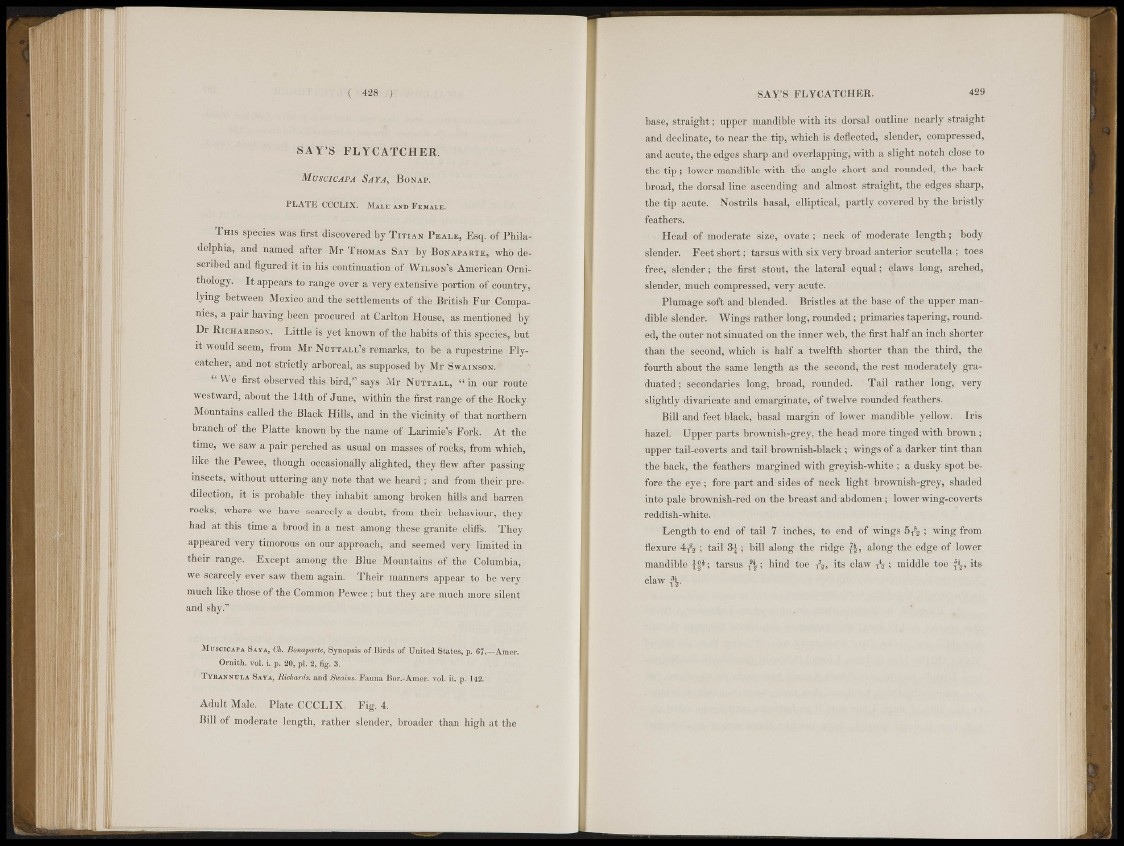
( < mm
i S i i f ' S FLYCATCHER.
Muscicai'a Saya, Bo nap.
1'I.ATE CCCI.IX. MATA: A.m> Kkmai.»:.
T H I S spBeiSs was first discovered by T ITIAN I'KAI.K, KSC(. of Philadelphia,
and named after Mr THOMAS SAY by BOKAPA&TK, who des
c r i e d and figured it in his cont.imiat.iotn.fe'f W'ii.so.n-'s American Ornithology.
It appears to range! oyer a very extensive portion of country,
lying between Mexico :and the isottlmnonis of the British I'ur Compu,
nioa> a Ii a i p having been procured at: Carlton HaasS^a« mentioned by
Dr IiiciiARiisow Little is yet lfiiown of theihabits of this species, but
i t would seem, from Mr NI:TTAI.L'S remarks, to he a rupestrmo I'LVcateller,
and not strictly arboreal, as supposed by Mr SWAXNXIK. •
- " Wo -first- observed this bird,'" says Mr NLTTAI.I., in our route
westward, about the 14th of .luno, within the first, range of this Eocky
Mountains called tlie Black Hills, arid in the vicinity of that northern
branch of the Platte known by the name of Larimie's Fork. At the
tiinej we saw a pair perched-as: usual on masses of rocks, from which,
lite a® Pewee, though occasionally alighted, they flew after passing
insects,- without uttering any note that we' hoard ;- and -from their predilection,
it is: probable tlicy inhabit among.;brok:<m hills and barren
rocks, where we; have' scarcely a doubt, from their, behaviour, they
had at this time a brood in a nefct among those .'granite «lifts. They,
appeared very timorous on our ¿approach, and - seemed very limited in
their range. Except among the Blue Mountains of the Columbia,.
We scarcity ever saw them again. Their manners appear to be -Very
much like those of the Common Pewee.; but they are much more silent
and .shy."
Mi;scrcAPA Saya, Ok. /hmpane, Synops-is of Birds of United S i te», p. liT. Amor.
' Ornith.' tok i. p. 20. pi. 2, tig. 3.
1 y h a n vt:i. a S a t a . tiich-jnls. and Smiim. Fauna Bor.-Amer. vol. ii. p. 142.
Adult Malci • Plate CCCI.IX. Fig. I.
Bill of moderate length, rather slender, broader than high at the
SAY'S FLYCATCHER. 429
base, straight ; upper mandible with its dorsal outline nearly straight
and decimate, to near the tip, which is deflected, slender, compressed,
and acute, the edges sharp and overlapping, with a slight notch close to
the tip ; lower mandible with tfie angle short and rounded, the back
broad, the dorsal line ascending and almost straight, the edges sharp,
the tip acute. MqsftSls. basal, ^elliptical, partly covered by the bristly
feathers.
Head of moderate size, ovate ; néck of moderate length; body
slender. Fëwt short; tarsus with six very broad anterior scutella ; toes
free, slender ; the first .stout, the lateral equal ; êlaws long, arched,
slender, much compressed,- very acute.
• Plumage soft and blended. Bristles at the base of the upper mandible
slender; Wings rather long, rounded ; primaries tapering, roundid,
the outer not sinuatedjm the inner web, the first half an inch shorter
than the second, which fig' half a twelfth shorter than the third, the
fourth about the same length as thé: second, the rest moderately graduated
; secondaries long; broad, rounded. Tail rather long, very
slightly divaricate and einarginate, of twelve rounded feathers.
Bill and'féefc black, basal margin of lower mandible yellow- Iris
hazel. Upper parts brownish-grey, the head more tinged with brown ;
tipper tail-covêrts and tail brownish-black ; wings of a darker tint than
the back, thé feathers margined with greyish-white ; a dusky spot before
the eye'; fore part andsides of neck light brownish-grey, shaded
into pale brownish-red on the breast and abdomen ; lower wing-coverts
reddish-white.
Length to end of tail 7 inches, to end of wings 5f
8i ; wing from
flexure 4& ; tail 3J ; bill along the ridge along the edge of lower
mandible ^ ; tarsus ; hind toe fg, its claw tV ; middle toe its
claw j1^.